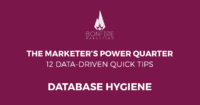Google Analytics is arguably one of the most powerful analytics platforms, and it’s completely free. But Google Analytics provides so much information, it can be intimidating to even find a place to start. And once you find your key metrics, what do those numbers mean to you and your performance?
In this Metrics Monday, I outline the three key metrics everyone should pay attention to, where to find them within Google Analytics, and generally accepted benchmarks for measuring your website’s performance.
Traffic sources
By looking at your traffic sources, you’ll be able to see how people are landing on your website and what sources drive the most and least traffic. The main sources include:
- Organic search: Visitors who come to your site after using a search engine.
- Direct: Visitors who typed your URL directly into their browser.
- Referral: Visitors who come to your site through any off-page marketing efforts, such as a backlink on another website.
- Social: Visitors who access your website through social media profiles and content.
- Paid search: Visitors who find your site through search engine marketing or other digital advertising.
Traffic sources are key because they show which marketing activities and campaigns are effectively driving traffic to your website. It can show where to intensify your efforts. For example, if you notice 50 percent of your traffic is from organic search, continue investing in your SEO strategy. Traffic analytics can also highlight a problem that needs to be addressed, like heavy spending in paid search without yielding high traffic.
Where to find it: Acquisition > Overview will give a high level view of traffic sources.

By navigating to Acquisition > All traffic > Channels you’ll be able to see a more in-depth analysis of each traffic source, including sessions, new users, and time on site.

You can also click on each traffic source and get even more granular on where visitors are coming from. By clicking on social, you’ll see a full breakdown of each social platform and how many visitors are coming from each.

Benchmark: This depends on where you are focusing marketing efforts. Ensure your source breakdown is aligned with where you’re investing heavily. Heavy SEO investment means larger organic search traffic.
Bounce rate
Bounce rate is the percentage of visitors who come to your site and leave without viewing any other pages or interacting with your site in any other way. It’s one of your primary engagement metrics. Bounce rate will help determine if you’re finding and retaining the right audience, if they’re finding the content they want and immediately leaving, or if they’re not finding what they want at all.
Where to find it: Behavior > Site content > All pages

Benchmark: There’s no one-size-fits-all bounce rate, and your ideal benchmark will depend on the goal of each page. Generally speaking, for your home page, you’ll want your bounce rate to be between 40 and 60 percent. For a specific landing page or form fill, a bounce rate between 70 and 90 percent is actually a good sign, because users are getting everything they need from the landing page.
Average session duration
The total average session duration for your website will give you a general idea of how long visitors stay on your site but it isn’t nearly as powerful as diving into the average session duration for individual pages on your site. It too is an engagement metric.
Where to find it: For overall site average session duration: Audience > Overview. For a different high level view of your entire site, navigate to the Audience Report > Behavior > Engagement to see session duration in seconds and page depth. For content specific average session duration: Behavior > Site content > Content drilldown.

Benchmark: The industry standard is between two and three minutes. But keep in mind the content of each of your pages. For simple pages such as a contact page, it might be much lower (which is fine). For in-depth blogs, you’ll want it to be a little higher.
No single metric can define success; they are each a piece of the puzzle. These three will give you an understanding of how people are getting to your site, how long they’re staying, and if they found what they were looking for.
Related resources:
More Content
How to Create Personas With Google Analytics
Personas are critical for the success of your marketing efforts, digital or not. Strong personas are a reference for every department in your company or agency — from strategy to
The Marketer’s Power Quarter: Updating Lead Databases
This is the tenth in a 12-part series of quick-fix tips to improve your digital marketing results. Catch up on our last tip, and subscribe to our newsletter to get the
AI in Marketing: How to Get Started in 2018
One of the biggest buzzwords in marketing, and really across many industries, is artificial intelligence. For years, a majority of the public viewed AI as science fiction, but that’s starting




Leave A Comment